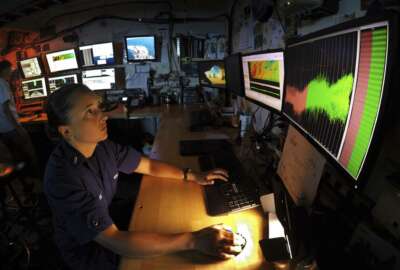
Emergency responders pivoting to virtual training as coronavirus collides with hurricane season
Though federal disaster preparedness and response agencies tend to hold up experiential training as the gold standard, the coronavirus pandemic is prompting a pivot...
Talk to federal disaster preparedness and response agencies like FEMA, the U.S. Coast Guard, the National Guard and the National Oceanographic and Atmospheric Administration about training, and one thing comes to the surface repeatedly: Experiential training is the gold standard.
To prepare their employees to do the work of saving lives in a disaster response situation, these first responders emphasize exercises that put their employees through their paces. But what happens when a pandemic prevents those employees from coming together physically to do just that?
“I don’t think there’s any substitute for actually exercising a plan,” USCG Vice Adm. Steven Poulin, who took over as commander of the Coast Guard Atlantic Area last month, told Federal News Network. “We’re doing as much as we can virtually to ensure readiness, and we are ready, and we’re going to continue to be ready.”
Maj. Gen. Steven Nordhaus, director of the National Guard Bureau of Operations, echoed those sentiments during a June 22 call with reporters.
“Though conditions change to include challenges with COVID-19 and the virus, the National Guard will be ready to respond. Our motto, as you probably previously know, is ‘always ready, always there,’” he said. “Recently, we’ve conducted virtual conferences with the 54 [states and territories] and our partners. We’ve conducted tabletop exercises to include FEMA, [the U.S. Northern Command] and our [Defense Department] partners. We know things will be different this year: Social distancing, PPE, screening and testing, sheltering and other impacts will cause us to change and we respond. But we will be ready.”
On the preparedness side, Andy Bailey, a National Weather Service warning coordination meteorologist in Kansas City/Pleasant Hill, also emphasized the benefits of exercises and experience in NWS’ StormReady program, which helps local communities benchmark their preparedness for extreme weather events. The program focuses on weather threats specific to various regions of the country, so StormReady might focus on tornadoes in the Midwest, hurricanes on the Atlantic Coast, or winter storms in the north.
“For us, [experiential training] tends to be the best. We’re not trying to turn our partners into meteorologists,” he said in an interview with Federal News Network. “We’re trying to help them interpret the meteorological products that we produce, and oftentimes exercises are one of the best ways best ways to provide that training.”
Read more: Workforce News
That said, Bailey described one way NWS has experimented with virtual collaboration software that actually predates the pandemic.
“Several offices have experimented with having an open webinar channel where there’ll be a radar loop constantly running. That then allows partners to join or leave if they have specific questions. It allows the meteorologists to talk about the current state of the radar and what we’re expecting from those storms, how we’re expecting them to evolve. We found that to be really helpful when our local partners have special events above and beyond what they’re normally dealing with,” he said. “That sort of support via webinar feed has been pretty popular with our partners when they need real time information and real time meteorological expertise explained in a way that goes beyond just speaking or typing it out. A picture is worth a thousand words, and when you can see that sort of information on the computer screen, it does make a big difference.”
And Steve Goldstein, NOAA’s liaison to FEMA, said the two agencies train for continuity of operations in any number of environments, which can run the gamut from working remotely to geographically shifting entire operations centers, like Miami’s National Hurricane Center or FEMA’s National Response Coordination Center, in case those facilities are impacted by storms.
“We have regular drills where we practice these things all the time,” Goldstein said in an interview with Federal News Network. “Continuity of operations is obviously incredibly important because we need to make sure that the data still flows to the decision makers, even if we have problems with our facilities.”
He said that since the pandemic, training sessions have continued virtually, and forecasters are providing support remotely. Even before the pandemic, he said, FEMA provided a comprehensive online training regimen. And the NWS’ incident meteorology program, which is primarily geared toward forest fire response, has also included a combination of virtual training and on-site exercises prior to the pandemic.
FEMA has also recently released its operational guidance for hurricane season that includes a section about dealing with the coronavirus, and offered virtual training in the form of webinars to supplement this guidance.
Copyright © 2025 Federal News Network. All rights reserved. This website is not intended for users located within the European Economic Area.
Daisy Thornton is Federal News Network’s digital managing editor. In addition to her editing responsibilities, she covers federal management, workforce and technology issues. She is also the commentary editor; email her your letters to the editor and pitches for contributed bylines.
Follow @dthorntonWFED





